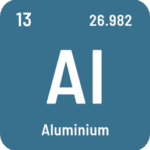Table of Contents
 What is ALUMINUM (Al)?
What is ALUMINUM (Al)?
Aluminum (Al, Latin aluminum) – a chemical element from the XIII group of the periodic table, the so-called boletus*. It is one of the most common elements in the earth’s crust, its content both in the free and bound state is about 8.2%. Aluminum is a silvery-white metal with a blue glow and high plasticity. In the natural environment, it occurs only in the oxidized form, in the form of oxides, the so-called corundum (Al2O3), aluminosilicates and hydroxides (Al(OH)3). Aluminum is chemically active, it occurs mainly in +III oxidation state, very rarely in +I and +II. Its complexity in terms of chemical properties affects the effect of the element on animals living in seawater.
Importance of ALUMINUM (Al) in seawater
The presence of aluminum in seawater is mainly due to human activities, such as the use of various aluminum-based products (e.g. adhesives, PO4) adsorbers). In addition, ceramic ornaments are a source of aluminum.
The biological importance of aluminum to marine animals is not fully understood. Aluminum at low concentrations may have little effect on brightening the colors of stony corals. Aluminum exceedances negatively affect the health of marine animals, although up to a certain concentration level in water, aluminum does not seem to be toxic to corals.
Aluminum in seawater occurs in several forms as: colloidal solution, solid particles and, to a small extent, in organic form.
Most often, however, it is a colloidal solution. Such solutions are characterized by being a heterogeneous mixture. This means that the colloidal solution of aluminum in seawater, when observed with the human eye, looks like a homogeneous solution (clear, without sediments, etc.), and in fact it is not mixed at the level of individual particles.
At the pH of seawater (8.0 – 8.5), aluminum hydrolyzes and the products are Al(OH)3 and Al(OH)4. Both compounds are very reactive with particles, therefore the removal of aluminum from seawater can be done by passive and active methods.
Risks associated with excess aluminum (Al) in seawater
The absence or low concentration of aluminum does not affect the health of marine animals. On the other hand, high concentrations have a negative effect, limiting the growth and expansion of polyps in most corals. With constantly elevated aluminum concentrations, the tissue in some corals becomes thinner and partially dies.
How to protect the aquarium?
The aluminum content should be checked regularly and maintained at the correct level. We recommend that you keep aluminum between 0 – 40 μg/L, with the optimal value we recommend being 0 μg/L. Keeping aluminum in seawater at the level of its detectability ensures animal health and beautiful coloration.
The most accurate and reliable method for determining aluminum is the ICP-OES analysis. The technique of atomic emission spectrometry with excitation in induced plasma – ICP-OES (Inductively Coupled Plasma Optical Emission Spectrometry) is the most accurate analytical method in the analysis of the elemental composition of sea water.
Indicators of abnormal levels of aluminum (Al) in a marine aquarium:
A group of corals is sensitive to high levels of aluminum in a saltwater aquarium. Changes are seen in corals such as Sarcophyton and Sinularia, which initially shrink and then decompose starting from the base.
With elevated concentrations of aluminum, the expansion of polyps is hindered – they have difficulty opening. In addition, dissolution of coral tissue can be observed.
Recommendations
To ensure the appropriate level of aluminum in the aquarium, you should systematically test it and ensure its proper level. If the aluminum level is above 40 μg/L, we are talking about an overdose. Sources of aluminum affecting aluminum growth in a reef tank:
- contaminated salt mixtures
- contaminated micronutrient supplements
- food for animals (such as artemia)
- filter media
- zeolites
- adsorbers
- decorations
- glues
- products used to stabilize the calcium economy (calcium reactors)
Find and eliminate the cause of the problem and lower the value of this parameter in the water. Do up to 6 water changes. It is recommended that at each water change approximately 15% of the aquarium water volume be replaced until the recommended value of this parameter is reached. Water prepared for replacement must be characterized by an appropriate level of target salinity. Use salt with the correct parameters and composition for the ICP test.
*The name of the boletes comes from the name of the first element placed at the top of the thirteenth column of the periodic table (B-boron).
About author

Magdalena Metzler
Privately, I am a mother and a lover of nature and sport. My main interest is quantum chemistry, which hides a whole lot of unsolved mysteries and connections, which is extremely exciting from a scientific point of view.
In my scientific career, I have conducted international projects focused on innovative solutions for many branches of business, e.g. automotive, construction, and now, of course, marine aquaristics.
Working at Reef Factory gave me a passion for marine aquaristics, which I can develop every day, building a chemistry department and creating products that will help aquarists take care of tanks and ensure the highest safety of animals. One of the most exciting memories of working at Reef Factory is the commissioning of the ICP-OES spectrometer, which analyzes the elemental composition of seawater. The method of analysis in ICP is based on an analytical technique, which is a combination of my passion for quantum chemistry and marine aquaristics.
I hope you find my articles on ReefPedia interesting and helpful! Happy reading :))


 What is ALUMINUM (Al)?
What is ALUMINUM (Al)?